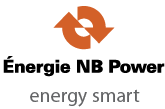Reading a Typical Bill
Your monthly power bill includes information to help you understand your usage and costs.
Below we describe different parts of a typical NB Power bill for a residential customer.
-
1. Customer identity
Your name and property address. If there is a joint customer sharing the bill, their name will be found on the right side of this area.
top of page -
2. Summary of charges
Your monthly account information and overview.
This is where you’ll find:
Previous balance – amount owing or credit from previous billing cycle.
Payments received – a record of recent payments made towards your balance.
Current billing period – the dates your charges cover.
Monthly service charge – a charge for non-consumption related assets, such as meters, poles, wires, tree trimming, etc. It is charged monthly if service is active, whether you choose to use electricity during the billing period or not.
Late payment charge – amount owing in addition to your balance if you didn’t pay your last bill before the due date. The charge is 1.5% per month (effective annual rate of 19.56% per annum or .04896% compounded daily rate). The minimum late payment charge is $0.50. If an account is less than $4.00 in arrears, no late payment charge is applied.
Charges for electricity you used – these are the charges for the energy you used in kilowatt hours.
Actual Charges – for those on an Equalized Payment Plan (EPP), this what you owe before the EPP amount is applied. Your monthly EPP amount is listed below and is the amount you owe for the month. The difference is then added to your EPP balance.
Late payment date – this is when a late payment charge may apply if you haven’t paid your bill.
Estimates – your estimated amount in the event your meter is unable to be read. Even if you have a smart meter, estimates may be necessary from time to time. There could be situations where the meter stops communicating with NB Power, which would make an estimation of usage necessary for billing.
top of page -
3. Variance account credit
Regulation now requires NB Power to file a Variance Account Recovery for the previous fiscal year with the New Brunswick Energy and Utilities Board. In 2022/23, the actual costs of delivering electricity came in lower than anticipated. As a result, starting in April 2023, this line on your bill indicates you are receiving a credit for 12 months. Learn more about the Variance Account Recovery Filing.
top of page -
4. Additional information
The section below the Summary of Charges may contain:
Equalized Payment Plan (EPP) information – if you’re an EPP customer, you’ll see information both in the Summary of Charges section and directly below it. This will include your monthly EPP amount as well as the actual charges. It will also contain your EPP balance, your annual settlement month, your EPP payments and your actual charges during the EPP plan year up until the date you receive your bill. Learn more about how EPP can help with budgeting.
Reasons for meter estimate – NB Power makes every effort to read your meter monthly. Estimates generally occur on days when a weather event is ongoing which prevents meter readers from being able to read the meter. In some cases, a meter reading can also be estimated if the meter is inaccessible. An inaccessible meter could include the conditions of a road or the driveway on the way to a customer’s location. Estimated meter readings are based on 3 components:
- the previous month’s consumption of the customer
- historical consumption pattern for the time of year
- adjustments to accurately reflect recent weather conditions
These estimates do not reflect your actual consumption. If there was an abnormality in the previous month’s consumption, this may result in a less accurate estimated meter reading. If a meter is over or underestimated, we will adjust the next bill to reflect the difference. If a meter was overestimated, the next bill will be lower. If the bill was underestimated, the next bill will be higher to reflect your consumption according to the actual meter reading.
top of page -
5. Bill and account details
Your account number, bill date, bill number, rate category and meter number. If your meter reading needs to be converted into kilowatt hours ( if you have a four-dial meter or another meter not capable of measuring the entire voltage or current), a multiplier will appear in the table titled Your electricity use this period.
top of page -
6. Your electricity use this period
Where you can see the date your meter was read, the reading and the previous reading. You’ll also see your energy use in kWh for the billing period. This is where you can find out if your meter was estimated.
top of page -
7. Your electricity use at a glance
Compares energy consumption and cost for the previous month, as well as the same billing month the year prior. This table only includes electricity charges; not service charges, rental fees or taxes.
top of page -
8. Number of billing days
Depending on when your meter is read, some months will have slightly more or less days, which affects overall energy consumption. The typical range is 28 to 33 days in a billing period, although it can be less days depending on the circumstances. For example, if you just moved into a home, and your reading is scheduled to occur three days later, your invoice may only be for only three days.
top of page









